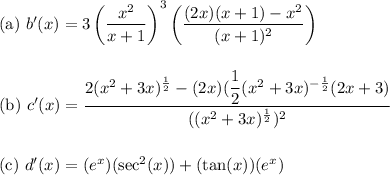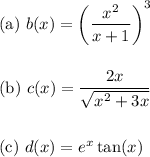Answer:

As per request, answers have been left unsimplified.
Explanation:
The task is to determine the derivatives of three given functions, and we will address each one individually. Here are our given functions:


For part (a):
We will apply the power rule, chain rule, and the quotient rule. Here are these rules written out:
![\boxed{\left\begin{array}{ccc}\text{\underline{Power Rule:}}\\\\(d)/(dx)[x^n]=nx^(n-1)\end{array}\right}](https://img.qammunity.org/2024/formulas/mathematics/high-school/s8qoanw4jqnwomp01kw6dji5gg0wv0vwom.png)
![\boxed{\left\begin{array}{ccc}\text{\underline{The Chain Rule:}}\\\\(d)/(dx)[f(g(x))] =f'(g(x))\cdot g'(x)\end{array}\right}](https://img.qammunity.org/2024/formulas/mathematics/high-school/h8sbxyvsty4r9839te2w2eyg23rg16kpz4.png)
![\boxed{\left\begin{array}{ccc}\text{\underline{The Quotient Rule:}}\\\\(d)/(dx)\Big[(f(x))/(g(x)) \Big] = (f'(x)g(x)-f(x)g'(x))/((g(x))^2)\end{array}\right }](https://img.qammunity.org/2024/formulas/mathematics/high-school/62oq7jvjn3by3tsc7igcouhi5t1ue5ogi6.png)
We have,
![\Longrightarrow b(x)=\left((x^2)/(x+1)\right)^3\\\\\\\\(d)/(dx) [b(x)]=(d)/(dx)\left[\left((x^2)/(x+1)\right)^3\right]](https://img.qammunity.org/2024/formulas/mathematics/high-school/rhuy4vussqs2qpi7swmh4qwvwxa5j2sb7j.png)
Applying the power rule and chain rule:
![\Longrightarrow b'(x)=3\left((x^2)/(x+1)\right)^3 \cdot (d)/(dx)\left[(x^2)/(x+1)\right]](https://img.qammunity.org/2024/formulas/mathematics/high-school/y9r0j8ap606rq1aadeebe5f7fs26vozk9q.png)
To take the derivative of the expression on the far right, use the quotient rule:
![\Longrightarrow b'(x)=3\left((x^2)/(x+1)\right)^3 \cdot \left((((d)/(dx)[x^2])(x+1)-(x^2)((d)/(dx)[x+1]))/((x+1)^2)\right)](https://img.qammunity.org/2024/formulas/mathematics/high-school/642i0s8o20dpj50t1xby679t8mgumkz4mt.png)
Finishing the derivative we get,

For part (b):
To find the derivative of c(x), first change the square root to a power.
![\Longrightarrow c(x)=(2x)/(√(x^2+3x))\\\\\\\\\Longrightarrow c(x)=\frac{2x}{(x^2+3x)^{(1)/(2)}}\\\\\\\\\Longrightarrow (d)/(dx)[c(x)]=(d)/(dx)\left[\frac{2x}{(x^2+3x)^{(1)/(2)}}\right]](https://img.qammunity.org/2024/formulas/mathematics/high-school/16a1q2kdozn6baay81wd34pdh3jm36p8hg.png)
Now we can use the quotient rule:
![\Longrightarrow c'(x)= \frac{((d)/(dx)[2x])((x^2+3x)^{(1)/(2)})-(2x)((d)/(dx)[(x^2+3x)^{(1)/(2)}])}{((x^2+3x)^{(1)/(2)})^2}](https://img.qammunity.org/2024/formulas/mathematics/high-school/4o5upvzuxj0rprg79vcqa8v791r4s0pv92.png)
Use the chain rule to take the derivative of the expression to the 1/2 power:
![\Longrightarrow c'(x)= \frac{2(x^2+3x)^{(1)/(2)}-(2x)((1)/(2)(x^2+3x)^{-(1)/(2)}\cdot(d)/(dx)[x^2+3x])}{((x^2+3x)^{(1)/(2)})^2}](https://img.qammunity.org/2024/formulas/mathematics/high-school/3acaupsfuqbgqs4nf1btgi7myivixieq82.png)
Finishing the derivative, we get:

For part (c):
To differentiate d(x) we will use the following rules:
![\boxed{\left\begin{array}{ccc}\text{\underline{Product Rule:}}\\\\(d)/(dx)[f(x)g(x)]=f(x)g'(x)+g(x)f'(x) \end{array}\right }](https://img.qammunity.org/2024/formulas/mathematics/high-school/xqvvke57n5utu9behpp3cbqf6tk7rf36pb.png)
![\boxed{\left\begin{array}{ccc}\text{\underline{Exponetial Rule:}}\\\\ (d)/(dx)[e^x]=e^x\end{array}\right}](https://img.qammunity.org/2024/formulas/mathematics/high-school/yj2guicsaqvfdg9taqdnxrgssqxdto4rgx.png)
![\boxed{\left\begin{array}{ccc}\text{\underline{Tangent Rule:}}\\\\ (d)/(dx)[\tan(x)]=\sec^2(x)\end{array}\right}](https://img.qammunity.org/2024/formulas/mathematics/high-school/spr86td64s1irn60lbwrekg7pc352ma4li.png)
Start by using the product rule:
![\Longrightarrow d(x)=e^x \tan(x)\\\\\\\\\Longrightarrow (d)/(dx) [d(x)]=(d)/(dx) [e^x \tan(x)]\\\\\\\\\Longrightarrow d'(x)=(e^x)((d)/(dx) [\tan(x)])+(\tan(x))((d)/(dx) [e^x])](https://img.qammunity.org/2024/formulas/mathematics/high-school/4cias58fz0x6f2eis61c3p8y8npr9a4bht.png)
Now applying the exponential rule and tangent rule:

Thus, all derivatives have been found. None have been simplified as per your request.